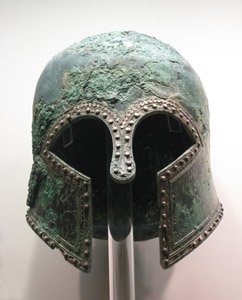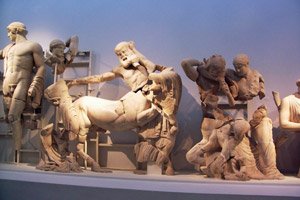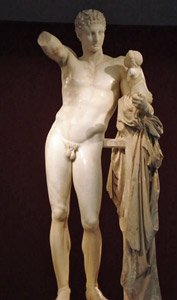The Archaeological Museum of ancient Olympia Greece was reorganized in 2004. The result is a museum which has superb displays of artifacts from the site of Olympia. As you walk from room to room you are led through centuries of Greek history, able to admire some of the most valuable and beautiful treasures of the ancient world.
What can you see
Walking around the site of ancient Olympia Greece, it’s difficult to imagine how it would have looked to the original inhabitants. There’s only a few columns which have been re-erected to give you a clue as to how it would have looked. As you enter the hallway of the museum, you can see models which show how the site would have looked with all the different structures – exercise areas, admin buildings, temples, etc.
One detail you’ll notice from the models of ancient Olympia Greece is colour. Today we admire the texture and colour of the stonework, whether it’s marble or some other stone. But the ancient Greeks liked colour, and to our eyes it would have looked quite gaudy! The colouring on the models is quite a revelation.

Central room
The rooms of the museum are arranged around the central area (room 5) which contains the metopes and pediment statues from the Temple of Zeus. The statues are displayed in the positions they would have occupied originally, and you can clearly see the triangular shape of the pediment.
The east pediment shows Zeus together with the king Oinomaos with his wife Sterope, daughter Hippodameia and her future husband Pelops. A chariot race is shown behind them.
The west pediment shows Apollo involved in the battle between the Centaurs and Lapiths.
The metopes from the pronaos and opisthodomos show the twelve labours of Heracles.

Surrounding rooms
The surrounding room 1 and 2 have remains from Early Helladic (15C BC) to the Geometric (7C BC) periods. There are quite a few artifacts of warfare on display. You’ll also see the circular acroterion which once stood on the apex of the pediment of the Temple of Hera.
One artifact which generates some debate is a helmet which has an inscription on it reading ‘Miltiades – dedicated to Zeus’. Miltiades was the Athenian general who led the Athenians at the battle of Marathon when they defeated the Persians. The style of helmet is correct for the period, but whether Miltiades himself dedicated it…
In rooms 3 and 4 you can see reconstructions of treasuries and bits and pieces from Pheidias’ workshop. But the most impressive item is the statue of Zeus and Ganymede which was made in about 470 BC. This is a half-size group made in terracotta.
The rest of the rooms (6 to 10) contain an equally impressive selection. There is the Nike statue made in marble from the island of Paros by the sculptor Paionios. It was to commemorate a victory over the Spartans, the most feared warriors of ancient Greece.

One of the most famous statues from ancient Olympia Greece, is that of Hermes and the young Dionysus, estimated to have been created in 350 BC. It was found in the Temple of Hera in the exact position where Pausanias claimed to have seen it. It shows Hermes taking the young Dionysus to the nymphs who will protect him as he grows up. Pausanias said it was the work of Praxiteles, but some now question this. It is claimed the footwear is of a later period, and therefore the date should be later, probably 2C BC.
And just in case anyone is skeptical about all this talk of the games in ancient Olympia Greece, in room 10 you can see a collection of ancient sports equipment.
All in all, this is a very impressive museum. The range of treasures here is amazing, and the way they are displayed only adds to your enjoyment.
